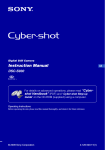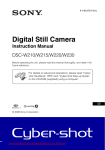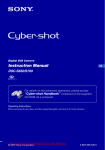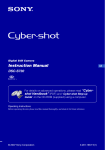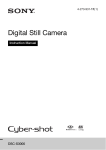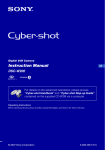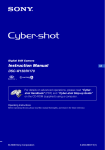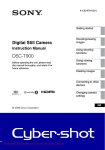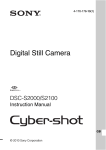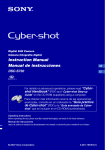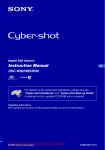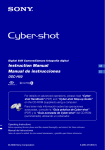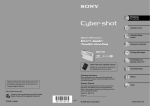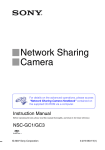Download Sony Cyber-shot DSC-S930 User`s Manual
Transcript
Digital Still Camera Instruction Manual GB DSC-S930 For details on advanced operations, please read “Cybershot Handbook” (PDF) and “Cyber-shot Step-up Guide” on the CD-ROM (supplied) using a computer. Operating Instructions Before operating the unit, please read this manual thoroughly, and retain it for future reference. Downloaded from ManualsCamera.com Manuals © 2009 Sony Corporation 4-126-520-11(1) Owner’s Record [ CAUTION The model and serial numbers are located on the bottom. Record the serial number in the space provided below. Refer to these numbers whenever you call upon your Sony dealer regarding this product. Model No. DSC-S930 Serial No. ______________________________ You are cautioned that any changes or modifications not expressly approved in this manual could void your authority to operate this equipment. WARNING To reduce fire or shock hazard, do not expose the unit to rain or moisture. For Customers in the U.S.A. If you have any questions about this product, you may call: Sony Customer Information Center 1-800-222-SONY (7669) The number below is for the FCC related matters only. [ Regulatory Information Declaration of Conformity Trade Name: SONY Model No.: DSC-S930 Responsible Party: Sony Electronics Inc. Address: 16530 Via Esprillo, San Diego, CA 92127U.S.A. Telephone No.: 858-942-2230 This device complies with Part 15 of the FCC Rules. Operation is subject to the following two conditions: (1) This device may not cause harmful interference, and (2) this device must accept any interference received, including interference that may cause undesired operation. [ Note: This equipment has been tested and found to comply with the limits for a Class B digital device, pursuant to Part 15 of the FCC Rules. These limits are designed to provide reasonable protection against harmful interference in a residential installation. This equipment generates, uses, and can radiate radio frequency energy and, if not installed and used in accordance with the instructions, may cause harmful interference to radio communications. However, there is no guarantee that interference will not occur in a particular installation. If this equipment does cause harmful interference to radio or television reception, which can be determined by turning the equipment off and on, the user is encouraged to try to correct the interference by one or more of the following measures: – Reorient or relocate the receiving antenna. – Increase the separation between the equipment and receiver. – Connect the equipment into an outlet on a circuit different from that to which the receiver is connected. – Consult the dealer or an experienced radio/TV technician for help. The supplied interface cable must be used with the equipment in order to comply with the limits for a digital device pursuant to Subpart B of Part 15 of FCC Rules. For the State of California, USA only Perchlorate Material - special handling may apply, See www.dtsc.ca.gov/hazardouswaste/perchlorate Perchlorate Material: Lithium battery contains perchlorate. 2 Downloaded from ManualsCamera.com Manuals For Customers in Europe [ Notice for the customers in the countries applying EU Directives The manufacturer of this product is Sony Corporation, 1-7-1 Konan Minato-ku Tokyo, 1080075 Japan. The Authorized Representative for EMC and product safety is Sony Deutschland GmbH, Hedelfinger Strasse 61, 70327 Stuttgart, Germany. For any service or guarantee matters please refer to the addresses given in separate service or guarantee documents. This product has been tested and found compliant with the limits set out in the EMC Directive for using connection cables shorter than 3 meters (9.8 feet). [ Attention The electromagnetic fields at the specific frequencies may influence the picture and sound of this unit. [ Notice If static electricity or electromagnetism causes data transfer to discontinue midway (fail), restart the application or disconnect and connect the communication cable (USB, etc.) again. [ Disposal of Old Electrical & Electronic Equipment (Applicable in the European Union and other European countries with separate collection systems) This symbol on the product or on its packaging indicates that this product shall not be treated as household waste. Instead it shall be handed over to the applicable collection point for the recycling of electrical and electronic equipment. By ensuring this product is disposed of correctly, you will help prevent potential negative consequences for the environment and human health, which could otherwise be caused by inappropriate waste handling of this product. The recycling of materials will help to conserve natural resources. For more detailed information about recycling of this product, please contact your local Civic Office, your household waste disposal service or the shop where you purchased the product. Downloaded from ManualsCamera.com Manuals 3 [ Disposal of waste batteries (applicable in the European Union and other European countries with separate collection systems) This symbol on the battery or on the packaging indicates that the battery provided with this product shall not be treated as household waste. By ensuring these batteries are disposed of correctly, you will help prevent potentially negative consequences for the environment and human health which could otherwise be caused by inappropriate waste handling of the battery. The recycling of the materials will help to conserve natural resources. In case of products that for safety, performance or data integrity reasons require a permanent connection with an incorporated battery, this battery should be replaced by qualified service staff only. To ensure that the battery will be treated properly, hand over the product at end-of-life to the applicable collection point for the recycling of electrical and electronic equipment. For all other batteries, please view the section on how to remove the battery from the product safely. Hand the battery over to the applicable collection point for the recycling of waste batteries. For more detailed information about recycling of this product or battery, please contact your local Civic Office, your household waste disposal service or the shop where you purchased the product. 4 Downloaded from ManualsCamera.com Manuals Table of contents Notes on using your camera .................................................................... 6 Getting started ................................................................................. 7 Checking the accessories supplied ......................................................... 7 1 Inserting the batteries/“Memory Stick Duo” media (sold separately) ................................................................................................................... 8 2 Turning the camera on/setting the clock ............................................. 10 Shooting images easily ................................................................. 11 Shooting mode/Zoom/Flash/Macro/Self-timer/Display/Image size ........ 12 Viewing/deleting images ............................................................... 14 Indicators on the screen ............................................................... 16 Changing the settings – Menu/Setup .......................................... 18 Menu items ............................................................................................. 20 Setup items ............................................................................................. 21 Enjoying your computer ............................................................... 22 Supported Operating Systems for USB connection and application software (supplied) ................................................................................. 22 Viewing “Cyber-shot Handbook” ............................................................ 23 Battery life and memory capacity ................................................ 24 Battery life and number of images you can record/view ........................ 24 Number of still images and recordable time of movies .......................... 25 Troubleshooting ............................................................................ 26 Batteries and power ............................................................................... 26 Shooting still images/movies .................................................................. 27 Viewing images ...................................................................................... 27 Precautions .................................................................................... 28 Specifications ................................................................................ 29 Downloaded from ManualsCamera.com Manuals 5 Notes on using your camera [ Internal memory and “Memory Stick Duo” media back up [ Notes on the LCD screen and lens Do not turn off the camera, remove the batteries, or remove the “Memory Stick Duo” media while the access lamp is lit. Otherwise, the internal memory data or “Memory Stick Duo” media may be damaged. Be sure to make a backup copy to protect your data. • The LCD screen is manufactured using extremely high-precision technology, so over 99.99% of the pixels are operational for effective use. However, some tiny black and/or bright dots (white, red, blue or green) may appear on the LCD screen. These dots are a normal result of the manufacturing process, and do not affect the recording. • When the battery level becomes low, the lens might stop moving. Insert new batteries or charged Nickel-Metal Hydride batteries and turn on the camera again. [ Notes on recording/playback • Before you start recording, make a trial recording to make sure that the camera is working correctly. • The camera is neither dust-proof, nor splashproof, nor water-proof. Read “Precautions” (page 28) before operating the camera. • Avoid exposing the camera to water. If water enters inside the camera, a malfunction may occur. In some cases, the camera cannot be repaired. • Do not aim the camera at the sun or other bright light. It may cause the malfunction of the camera. • Do not use the camera near a location that generates strong radio waves or emits radiation. Otherwise, the camera may not properly record or play back images. • Using the camera in sandy or dusty locations may cause malfunctions. • If moisture condensation occurs, remove it before using the camera (page 28). • Do not shake or strike the camera. It may cause a malfunction and you may not be able to record images. Furthermore, the recording media may become unusable or image data may be damaged. • Clean the flash surface before use. The heat of flash emission may cause dirt on the flash surface to become discolored or to stick to the flash surface, resulting in insufficient light emission. [ On image data compatibility • The camera conforms with DCF (Design rule for Camera File system) universal standard established by JEITA (Japan Electronics and Information Technology Industries Association). • Sony does not guarantee that the camera will play back images recorded or edited with other equipment, or that other equipment will play back images recorded with the camera. [ Warning on copyright Television programs, films, videotapes, and other materials may be copyrighted. Unauthorized recording of such materials may be contrary to the provisions of the copyright laws. [ No compensation for damaged content or recording failure Sony cannot compensate for failure to record or loss or damage of recorded content due to a malfunction of the camera or recording media, etc. 6 Downloaded from ManualsCamera.com Manuals Getting started Checking the accessories supplied • LR6 (size AA) alkaline batteries (2) • USB cable (1) • Wrist strap (1) • CD-ROM (1) – Cyber-shot application software – “Cyber-shot Handbook” – “Cyber-shot Step-up Guide” • Instruction Manual (this manual) (1) Attach the strap to prevent the camera from damage by being dropped. Downloaded from ManualsCamera.com Manuals Hook 7 1 Inserting the batteries/“Memory Stick Duo” media (sold separately) ɟ Terminal side ɠ 2 1 Battery/“Memory Stick Duo” media cover With the terminal side facing the LCD screen, insert the “Memory Stick Duo” media. 1 Open the battery/“Memory Stick Duo” media cover. 2 Insert the “Memory Stick Duo” media (sold separately) all the way in until it clicks. 3 Match +/– and insert. 4 Close the battery/“Memory Stick Duo” media cover. [ When there is no “Memory Stick Duo” media inserted The camera records/plays back images using the internal memory (approx. 12 MB). [ Batteries you can and cannot use with your camera Battery type supplied supported rechargeable LR6 (size AA) alkaline batteries a a – HR 15/51:HR6 (size AA) Nickel-Metal Hydride batteries – a a ZR6 (size AA) Oxy Nickel Primary Battery – a – Manganese batteries* – – – Lithium batteries* – – – – – – Ni-Cd batteries* * Operating performance cannot be ensured if voltage drops or other problems are caused by the nature of the battery. 8 Downloaded from ManualsCamera.com Manuals [ WARNING Battery may explode or leak if mistreated. Do not recharge, disassemble or dispose of in fire. Check the valid date (month-year) displayed on the batteries. [ To check the remaining battery time Press the ON/OFF (power) button to turn on and check the time on the LCD screen. Battery remaining indicator Battery remaining guidelines Sufficient power remaining Battery half full Battery low, recording/ playback will stop soon. Replace the batteries with new ones, or fully charged NickelMetal Hydride batteries.(The warning indicator flashes.) • The battery remaining indicator may not be correct depending on conditions of use and circumstances. • When using alkaline batteries/Oxy Nickel Primary Battery, the battery remaining indicator may not display the correct information. [ To remove the batteries/“Memory Stick Duo” media Open the battery/“Memory Stick Duo” media cover. “Memory Stick Duo” media Make sure that the access lamp is not lit, then push the “Memory Stick Duo” media in once. Batteries Be sure not to drop the batteries. Access lamp • Never open the battery /“Memory Stick Duo” media cover or remove the batteries /“Memory Stick Duo” media, when the access lamp is lit. This may cause damage to data in the “Memory Stick Duo” media/ internal memory. Downloaded from ManualsCamera.com Manuals 9 2 Turning the camera on/setting the clock ON/OFF (power) button 1 ɟ Control button z button 2 3 1 Press the ON/OFF (power) button. 2 Set the clock with the control button. 1 Select the date display format with v/V, then press z. 2 Select each item with b/B and set the numeric value with v/V, then press z. 3 Select [OK], then press z. • The camera does not have a feature for superimposing dates on images. By using “PMB” in the CD-ROM (supplied), you can print or save images with the date. • Midnight is indicated as 12:00 AM, and noon as 12:00 PM. [ To change the date and time Select [Clock Settings] in the (Setup) screen (pages 18, 21). [ Notes on when the power is turned on • Once the batteries are inserted in the camera, it may take time before operation becomes possible. • If the camera is running on battery power and you do not operate the camera for about three minutes, the camera turns off automatically to prevent wearing down the batteries (Auto power-off function). 10 Downloaded from ManualsCamera.com Manuals Shooting images easily Macro button ɠ Shutter button DISP button Flash button Zoom (W/T) button Mode switch Self-timer button Control button Tripod receptacle (bottom) (Image Size) button 1 Select a mode with the mode switch. Still image: Select (Still image). Movie: Select (Movie). 2 Hold the camera steady, keeping your arms at your side. Position the subject in the center of the focus frame. 3 Shoot with the shutter button. Still image: 1 Press and hold the shutter button halfway down to focus. The z (AE/AF lock) indicator (green) flashes, a beep sounds, the indicator stops flashing and remains lit. 2 Press the shutter button fully down. The shutter sounds. AE/AF lock indicator Movie: Press the shutter button fully down. To stop recording, press the shutter button fully down again. • The shortest shooting distance is approximately 5 cm (2 inches) (W)/50 cm (1 feet 7 3/4 inches) (T) (from the front of the lens). Downloaded from ManualsCamera.com Manuals 11 Shooting mode/Zoom/Flash/Macro/Self-timer/Display/Image size [ Selecting the shooting mode for still images Press the MENU button and select [Camera], then select the desired mode. [ W/T Using the zoom Press T to zoom, press W to undo zoom. [ Auto Adjustment Allows easy shooting with the settings adjusted automatically. Program Auto Press B ( ) on the control button repeatedly until the desired mode is selected. : Flash Auto Allows you to shoot with the exposure adjusted automatically (both the shutter speed and the aperture value). You can adjust other settings using the menu. Strobes when there is insufficient light (default setting). : Flash forced on : Slow synchro (Flash forced on) The shutter speed is slow in a dark place to clearly shoot the background that is out of flash light. : Flash forced off Scene Selection Allows you to shoot with preset settings accoring to the scene. High Sensitivity Shoots images without a flash even in low lighting. Soft Snap Shoots a person’s skin with a warmer look. Landscape Shoots with the focus on a distant subject. Twilight Portrait Shoots sharp images of people in a dark place without losing the nighttime atmosphere. Twilight Shoots night scenes without losing the nighttime atmosphere. Flash (Selecting a flash mode for still images) [ Macro (Shooting close-up) Press b ( ) on the control button repeatedly until the desired mode is selected. : Auto The camera adjusts the focus automatically from distant subjects to close-up. Normally, put the camera in this mode. : Macro The camera adjusts the focus with priority on close-up subjects. Set Macro On when shooting close subjects. Beach Shoots seaside or lakeside scenes with the blueness of the water captured more vividly. Snow Shoots snow scenes in white more clearly. 12 Downloaded from ManualsCamera.com Manuals [ Using the self-timer Press V ( ) on the control button repeatedly until the desired mode is selected. : Not using the self-timer : Setting the 10-second delay self-timer : Setting the 2-second delay self-timer When you press the shutter button, the selftimer lamp flashes and a beep sounds until the shutter operates. Self-timer lamp [ DISP Changing the screen display Press v (DISP) on the control button. Each time you press v (DISP), the display changes as follows: Indicators on r Indicators on* r Histogram on* r Indicators off* [ To change the still image size Press (Image Size), then press b/B to select the size. To turn off the Image Size menu, press again. For still images Image size Guidelines : 10M Up to A3+/13×19" print : 3:2 (8M) Match 3:2 Aspect Ratio : 5M Up to A4/8×10" print : 3M Up to 13×18cm/5×7" print : VGA For E-mail : 16:9 Display On 16:9 HDTV and up to A4/8×10" print (7M) : 16:9 (2M) Display On 16:9 HDTV For movie The image size of a movie is fixed to 320×240. * The brightness of the LCD Backlight up Downloaded from ManualsCamera.com Manuals 13 Viewing/deleting images v/V/b/B button (Index) button (playback zoom) button MENU button z button Mode switch ɟ Control button (Delete) button 1 Select (Playback) with the mode switch. 2 Select an image with b/B on the control button. Movie: Press z to play back a movie. (Press z again to stop playback.) Press B to fast forward, b to rewind. (Press z to return to normal playback.) • You cannot listen to the audio with this camera when a movie is played back. [ To delete images 1 Display the image you want to delete and press the 2 Select [This Image] with b/B, then press z. 3 Select [OK] with v, then press z. [ (Delete) button. To view an enlarged image (playback zoom) Press (T) while displaying a still image. To undo the zoom, press W. Adjust the position with v/V/b/B. To cancel the playback zoom, press z. [ To view an index screen Press (Index) and select an image with v/V/b/B. To return to the single image screen, press z. 14 Downloaded from ManualsCamera.com Manuals [ To delete images in index mode 1 While an index screen is displayed, press the (Delete) button and select [Multiple Images] with b/B on the control button, then press z. 2 Select the image you want to delete with v/V/b/B, then press z. The mark is checked in the checkbox of the image. To cancel a selection, select an image you have selected for deletion, then press z again. 3 Press the MENU button. 4 Select [OK] with v, then press z. • To delete all the images of a folder, select [All In This Folder] in step 1, then press z. Downloaded from ManualsCamera.com Manuals 15 Indicators on the screen Each time you press v (DISP) on the control button, the display changes (page 13). A [ When shooting still images Battery remaining Low battery warning Image size Camera mode (Scene Selection) Camera mode (Program Auto) White balance Burst mode [ When shooting movies Metering mode Face Detection SteadyShot Vibration warning [ When playing back • Indicates vibration may prevent you from shooting clear images due to insufficient lighting. Even if the vibration warning appears, you can still shoot images. However, we recommend that you set the anti-blur function to [Auto], using the flash for better lighting or using a tripod or other means to stabilize the camera. Zoom scaling Color mode PictBridge connecting Protect Print order (DPOF) mark PictBridge connecting • Do not disconnect the USB cable while the mark is displayed. 16 Downloaded from ManualsCamera.com Manuals B 12/12 Image number/Number of images recorded in selected folder z AE/AF lock REC Standby Recording a movie/Standby a movie ISO400 ISO number • This does not appear when using internal memory. 125 Shutter speed Metering mode F3.5 Aperture value Flash +2.0EV Exposure Value White balance 0:12 Recording time (minutes : seconds) AF range finder frame indicator 1.0m Focus preset distance Macro Changing folder ISO400 ISO number +2.0EV Exposure Value 500 Shutter speed F3.5 Aperture value 00:00:12 Counter 101-0012 Folder-file number 2009 1 1 9:30 AM Recorded date/time of the playback image Self-timer z STOP z PLAY Function guide for playing image AF range finder frame BACK/ NEXT Selecting images D Spot metering cross hair C N Recording folder • This does not appear when using internal memory. 12 Playback Playback bar Histogram Number of recordable images Recording Media/Playback Media (“Memory Stick Duo” media, Internal memory) 00:00:15 Recordable time (hours : minutes : seconds) Red-eye reduction Flash mode Flash charging 101 Playback folder • This does not appear when using internal memory. Downloaded from ManualsCamera.com Manuals 17 Changing the settings – Menu/Setup MENU button z button ɟɠ Control button 1 Press the MENU button to display the menu. • The menu will be displayed only during shooting and playback mode. • Different items will become visible depending on the selected mode. 2 Select a desired menu item with v/V on the control button. • If the desired item is hidden, keep pressing v/V until the item appears on the screen. 3 Select a setting with b/B. • If the desired item is hidden, keep pressing b/B until the item appears on the screen. • Select an item in playback mode, then press z. 4 Press the MENU button to turn off the menu. 18 Downloaded from ManualsCamera.com Manuals For details on the operation 1 page 18 [ To select a Setup item Select (Setup) in step 2 and then press z. Select the item to set with v/V/B, then press z. Downloaded from ManualsCamera.com Manuals 19 For details on the operation 1 page 18 Menu items The available menu items vary depending on the mode switch position, and the shooting mode. Only the available items are displayed on the screen. Shooting menu Camera Selects the shooting mode. SteadyShot Selects the anti-blur mode. Face Detection Selects the priority subject for adjusting the focus when using face detection. REC Mode Selects the continuous shooting method. EV Adjusts Exposure. ISO Selects a luminous sensitivity. Metering Mode Selects the metering mode. Focus Changes the focus method. White Balance Adjusts the color tones. Flash Level Adjusts the amount of flash light. Red Eye Reduction Sets to reduce the red-eye phenomenon. Color Mode Changes the vividness of the image or adds special effects. (Setup) Changes Setup items. Viewing menu (Slideshow) Sets and performs the Slideshow (playback of a series of images). (Retouch) Retouches still images. (Multi-Purpose Resize) Changes the image size according to usage. (Protect) Prevents accidental erasure. Adds a Print order mark on image that you want to print out. (Print) Prints images using a PictBridge compliant printer. (Rotate) Rotates a still image. (Select Folder) Selects the folder for viewing images. (Setup) Changes Setup items. 20 Downloaded from ManualsCamera.com Manuals For details on the operation 1 page 18 Setup items Main Settings Beep Selects the sound produced when you operate the camera. Function Guide Displays the description of functions when you operate the camera. Initialize Initializes the setting to the default setting. USB Connect Selects the USB mode to be used when connecting the camera to a computer or a PictBridge compliant printer using the USB cable. Shooting Settings Grid Line Displays lines to easily set a subject in a horizontal or vertical position. Digital Zoom Selects the digital zoom mode. Auto Review Displays the recorded image on the screen for approximately two seconds immediately after shooting a still image. Memory Tool — Memory Stick Tool Format Formats the “Memory Stick Duo” media. Create REC.Folder Creates a folder in “Memory Stick Duo” media for recording images. Change REC.Folder Changes the folder currently used for recording images. Copy Copies all images in the internal memory to “Memory Stick Duo” media. Memory Tool — Internal Memory Tool Format Formats the internal memory. Clock Settings Clock Settings Sets the date and time. Language Setting Language Setting Selects the language to be used in the menu items, warnings, and messages. Downloaded from ManualsCamera.com Manuals 21 Enjoying your computer You can view images shot with the camera on a computer. By using the software in the CDROM (supplied), you can enjoy still images and movies from the camera more than ever. For details, refer to “Cyber-shot Handbook” in the CD-ROM (supplied). Supported Operating Systems for USB connection and application software (supplied) For Windows users For Macintosh users USB connection Windows 2000 Professional SP4, Windows XP*1 SP3, Windows Vista*2 SP1 Mac OS 9.1/9.2/ Mac OS X (v10.1 to v10.5) Application software “PMB (Picture Motion Browser)” Windows XP*1 SP3, Windows Vista*2 SP1 not compatible *1 *2 64-bit editions are not supported. Starter (Edition) is not supported. • Your computer must be pre-installed with an OS listed above. OS upgrades are not supported. • If your OS does not support USB connections, copy images by inserting the “Memory Stick Duo” media into the “Memory Stick” media slot on your computer, or use a commercially available “Memory Stick” media Reader/Writer. • For further details on the operating environment of “PMB” Cyber-shot application software, refer to “Cyber-shot Handbook”. 22 Downloaded from ManualsCamera.com Manuals Viewing “Cyber-shot Handbook” “Cyber-shot Handbook” in the CD-ROM (supplied) explains how to use the camera in detail. Adobe Reader is required to view it. [ For Windows users 1 Turn on your computer, and insert the CDROM (supplied) into the CD-ROM drive. [ For Macintosh users 1 Turn on your computer, and insert the CDROM (supplied) into the CD-ROM drive. 2 Select the [Handbook] folder and copy “Handbook.pdf” stored in the [GB] folder to your computer. 3 After copying is complete, double-click “Handbook.pdf”. The installation menu screen appears. When you click the [Cyber-shot Handbook] button, the screen for copying “Cyber-shot Handbook” appears. 2 Follow the on-screen instructions to copy. • When you install “Cyber-shot Handbook”, the “Cyber-shot Step-up Guide” will be installed automatically. 3 After the installation is complete, doubleclick the shortcut created on the desktop. Downloaded from ManualsCamera.com Manuals 23 Battery life and memory capacity Battery life and number of images you can record/view The numbers shown in the following tables assume new batteries are used at an ambient temperature of 25°C (77°F). The numbers shown for images you can record/view are approximations and allow for changing of the “Memory Stick Duo”media as necessary. Note that the actual numbers may be less than those indicated in the table depending on the conditions of use. [ When shooting still images Battery Alkaline Battery life (min.) No. of images Approx. 60 Approx. 120 • The measurement method is based on the CIPA standard. (CIPA: Camera & Imaging Products Association) • The battery life and the number of images do not change, regardless of image size. [ Notes on the batteries • The battery capacity decreases as the number of uses increases and also over time. • The battery life and the number of images you can record/view are decreased under conditions such as the following, etc.: – The surrounding temperature is low. – The flash is used frequently. – The camera has been turned on and off many times. – The zoom is used frequently. – The brightness of LCD Backlight is set to up. – The battery power is low. • The values shown for alkaline battery are based on commercial norms, and do not apply to all alkaline batteries in all conditions. The values may vary, depending on the battery manufacturer/type, environmental conditions, product setting, etc. • The supplied alkaline battery is for trial use only. You may need to purchase an additional battery for regular camera use. [ When viewing still images Battery Alkaline Battery life (min.) No. of images Approx. 280 Approx. 5600 • Viewing single images in order at about three second intervals 24 Downloaded from ManualsCamera.com Manuals Number of still images and recordable time of movies The number of still images and the length of time for movies may vary depending on the shooting conditions and the recording mediums. • Even if the capacity of your recording media is the same as the one in the table below, the number of still images and the length of time for movies may be different. • For details on the image size, see page 13. [ The approximate recordable number of still images (Units: Images) Capacity Internal memory Approx. 12MB Size “Memory Stick Duo” media formatted with this camera 256MB 512MB 1GB 2GB 4GB 8GB 16GB 10M 2 58 115 230 470 940 1900 3800 3:2 (8M) 2 58 115 230 470 940 1900 3800 5M 4 90 170 350 710 1420 2900 5850 3M 7 148 293 600 1200 2400 4850 9800 60 1200 2360 4800 9650 19300 38600 77200 VGA 16:9 (7M) 3 75 150 300 600 1200 2450 5000 16:9 (2M) 11 230 450 900 1800 3700 7500 15000 • The number of images listed assume [REC Mode] is set to [Normal]. • When the number of remaining shootable images is greater than 9,999, the “>9999” indicator appears. • When an image was recorded using an earlier Sony model and is played back on the camera, the image may not appear in the actual image size. [ The approximate recordable time of movies The numbers in the table below show the approximate maximum recordable time obtained by totaling all movie files. (Units: hour : minute : second) Capacity Internal memory “Memory Stick Duo” media formatted with this camera Size Approx. 12MB 256MB 512MB 1GB 2GB 4GB 320×240 0:00:20 0:10:10 0:20:20 0:41:20 1:23:40 2:45:00 8GB 16GB 5:35:00 11:18:00 • The aspect ratio of the movie frame is 320×240 • Recordable movie file size is up to approx. 2 GB for each file. If the file size reaches approx. 2 GB, the camera stops recording automatically. • The camera does not support HD recordings or playbacks for movies. Downloaded from ManualsCamera.com Manuals 25 Troubleshooting If you experience trouble with your camera, try the following solutions. 1 Check the items below, and refer to “Cyber-shot Handbook” (PDF). 2 Remove the batteries, wait for about one minute, re-insert the batteries, then turn on the power. 3 Initialize the settings (page 21). 4 Consult your Sony dealer or local authorized Sony service facility. Be aware that by sending the camera for repair, you give consent that the contents of the internal memory may be checked. Batteries and power The battery remaining indicator is incorrect, or sufficient battery remaining indicator is displayed but the power runs out too quickly. • This phenomenon occurs when you use the camera in an extremely hot or cold location. • When using alkaline batteries/Oxy Nickel Primary Battery (sold separately), the displayed time remaining may not be correctly indicated. • The batteries are discharged. Insert new batteries or charged Nickel-Metal Hydride batteries (sold separately) (page 8). • When using the Nickel-Metal Hydride batteries, the poles of batteries or the terminals of the battery cover are dirty so the batteries are not charged sufficiently. Clean them with a cotton swab, etc. • When using the Nickel-Metal Hydride batteries, the displayed time remaining differs from the current one due to the memory effect, etc. Fully discharge and then charge the batteries to correct the display. • The batteries are dead. Replace them with new ones (page 8). The batteries run down too quickly. • You are using the camera in an extremely cold location. • The batteries are dead. Replace them with new ones. • When using the Nickel-Metal Hydride batteries, charge them sufficiently. Camera power is turned off automatically when you open the battery/“Memory Stick Duo” media cover. • This is not a malfunction. Turn off the camera before you open the battery/“Memory Stick Duo” media cover. 26 Downloaded from ManualsCamera.com Manuals Cannot turn on the camera. • Insert the batteries correctly (page 8). • The batteries are discharged. Insert new batteries or charged Nickel-Metal Hydride batteries (page 8). • The batteries are dead. Replace them with new ones. The power turns off suddenly. • If you do not operate the camera for about three minutes while the power is on, the camera turns off automatically to prevent wearing down the batteries. Turn on the camera again (page 10). • The batteries are discharged. Insert new batteries or charged Nickel-Metal Hydride batteries (page 8). Shooting still images/movies Cannot record images. • Check the free capacity of the internal memory or “Memory Stick Duo” media (page 25). If it is full, do one of the following: – Delete unnecessary images (page 14). – Change the “Memory Stick Duo” media. • You cannot record images while charging the flash. • Set the mode switch to (Still image) when shooting still images. • Set the mode switch to (Movie) when shooting movies. Cannot insert dates on images. • The camera does not have a feature for superimposing dates on images. By using “PMB”, you can print or save images with the date. Vertical streaks appear when you are shooting a very bright subject. • The smear phenomenon is occurring and white, black, red, purple, or other streaks appear on the image. This phenomenon is not a malfunction. Viewing images Cannot play back images. • Set the mode switch to (Playback) (page 14). • The folder/file name has been changed on your computer. • Sony does not guarantee playback of image files on the camera if the files have been processed using a computer or recorded with another camera. • The camera is in USB mode. Delete the USB connection. Downloaded from ManualsCamera.com Manuals 27 Precautions [ Do not use/store the camera in the following places • Do not leave the camera in contact with rubber or vinyl for a long time. • In an extremely hot, cold or humid place In places such as in a car parked in the sun, the camera body may become deformed and this may cause a malfunction. • Under direct sunlight or near a heater The camera body may become discolored or deformed, and this may cause a malfunction. • In a location subject to rocking vibration • Near strong magnetic place • In sandy or dusty places Be careful not to let sand or dust get into the camera. This may cause the camera to malfunction, and in some cases this malfunction cannot be repaired. [ On operating temperatures [ On carrying Do not sit down in a chair or other place with the camera in the back pocket of your trousers or skirt, as this may cause malfunction or damage the camera. [ On the battery • Avoid rough handling, disassembling, modifying, physical shock, or impact such as hammering, dropping or stepping on the battery. • Do not use a deformed or damaged battery. • Do not mix a used battery together with a new battery or different types of batteries. [ On cleaning Cleaning the LCD screen Wipe the screen surface with an LCD cleaning kit (sold separately) to remove fingerprints, dust, etc. Cleaning the lens Wipe the lens with a soft cloth to remove fingerprints, dust, etc. Cleaning the camera surface Clean the camera surface with a soft cloth slightly moistened with water, then wipe the surface with a dry cloth. To prevent damage to the finish or casing: • Do not expose the camera to chemical products such as thinner, benzine, alcohol, disposable cloths, insect repellent, sunscreen or insecticide. • Do not touch the camera with any of the above on your hand. Your camera is designed for use under the temperatures between 0°C and 40°C (32°F and 104°F). Shooting in extremely cold or hot places that exceed this range is not recommended. [ On moisture condensation If the camera is brought directly from a cold to a warm location, moisture may condense inside or outside the camera. This moisture condensation may cause a malfunction of the camera. If moisture condensation occurs Turn off the camera and wait about an hour for the moisture to evaporate. Note that if you shoot with moisture remaining inside the lens, images will not be clear. [ On the internal rechargeable backup battery This camera has an internal rechargeable battery for maintaining the date and time and other settings regardless of whether the power is on or off. This rechargeable battery is continually charged as long as you are using the camera. However, if you use the camera for only short periods, it discharges gradually, and if you do not use the camera at all for about one month it becomes completely discharged. In this case, be sure to charge this rechargeable battery before using the camera. However, even if this rechargeable battery is not charged, you can still use the camera, but the date and time will not be indicated. Charging method of the internal rechargeable backup battery Insert batteries with enough power remaining in the camera, and leave the camera for 24 hours or more with the power off. 28 Downloaded from ManualsCamera.com Manuals Specifications Camera [System] Image device: 7.7 mm (1/2.3 type) color CCD, Primary color filter Total pixel number of camera: Approx. 10.3 Megapixels Effective pixel number of camera: Approx. 10.1 Megapixels Lens: 3× zoom lens f = 6.4 – 19.2 mm (36 – 108 mm (35 mm film equivalent)) F2.9 (W) – 5.4 (T) Exposure control: Automatic exposure, Scene Selection (7 modes) White balance: Automatic, Daylight, Cloudy, Fluorescent 1, 2, 3, Incandescent, Flash File format: Still images: JPEG (DCF Ver. 2.0, Exif Ver. 2.21 ) compliant, DPOF compatible Movies: AVI (Motion JPEG) Recording media: Internal Memory (approx. 12 MB), “Memory Stick Duo” media Flash: Flash range (ISO sensitivity (Recommended Exposure Index) set to Auto): approx. 0.5 to 3.0 m (1 feet 7 3/4 inches to 9 feet 10 1/8 inches) (W)/approx. 0.5 to 1.5 m (1 feet 7 3/4 inches to 4 feet 11 1/8 inches) (T) Recording interval of Burst: Approx. 1.0 seconds Design and specifications are subject to change without notice. [Input and Output connectors] USB communication: Hi-Speed USB (USB 2.0 compliant) [LCD screen] LCD panel: 6.0 cm (2.4 type) TFT drive Total number of dots: 112 320 (480×234) dots [Power, general] Power: LR6 (size AA) Alkaline batteries (2), 3 V HR15/51:HR6 (size AA) Nickel-Metal Hydride batteries (2) (sold separately), 2.4 V ZR6 (size AA) Oxy Nickel Primary Battery (2) (sold separately), 3 V Power consumption (during shooting): 1.2 W Operating temperature: 0 to 40°C (32 to 104°F) Storage temperature: –20 to +60°C (–4 to +140°F) Dimensions: 89.5×61.0×26.1 mm (3 5/8 × 2 1/2 × 1 1/16 inches) (W/H/D, excluding protrusions) Mass: Approx. 167 g (5.9 oz) (including two batteries and strap, etc.) Microphone: Monaural Buzzer Exif Print: Compatible PRINT Image Matching III: Compatible PictBridge: Compatible Downloaded from ManualsCamera.com Manuals 29 Trademarks • The following marks are trademarks of Sony Corporation; , “Cyber-shot”, “Memory Stick”, , “Memory Stick PRO”, , “Memory Stick Duo”, , “Memory Stick PRO Duo”, , “Memory Stick PRO-HG Duo”, , “Memory Stick Micro”, “MagicGate”, • Microsoft, Windows, DirectX and Windows Vista are either registered trademarks or trademarks of Microsoft Corporation in the United States and/or other countries. • Macintosh, Mac OS, iMac, iBook, PowerBook, Power Mac and eMac are trademarks or registered trademarks of Apple Inc. • Intel, MMX, and Pentium are trademarks or registered trademarks of Intel Corporation. • Adobe and Reader are either registered trademarks or trademarks of Adobe Systems Incorporated in the United States and/or other countries. • In addition, system and product names used in this manual are, in general, trademarks or registered trademarks of their respective developers or manufacturers. However, the ™ or ® marks are not used in all cases in this manual. 30 Downloaded from ManualsCamera.com Manuals Downloaded from ManualsCamera.com Manuals Additional information on this product and answers to frequently asked questions can be found at our Customer Support Website. Printed on 70% or more recycled paper using VOC (Volatile Organic Compound)-free vegetable oil based ink. Printed in Chinafrom Downloaded ManualsCamera.com Manuals
































